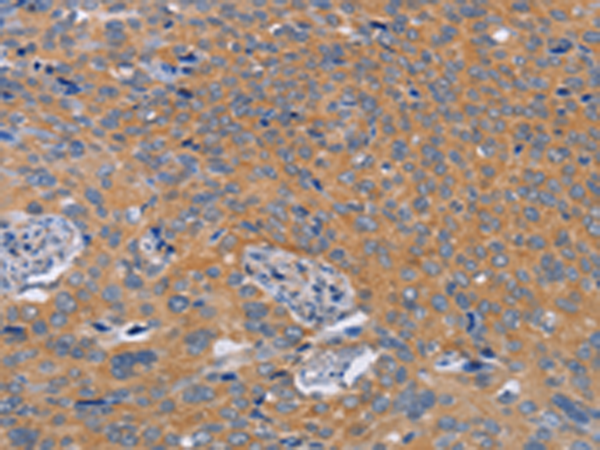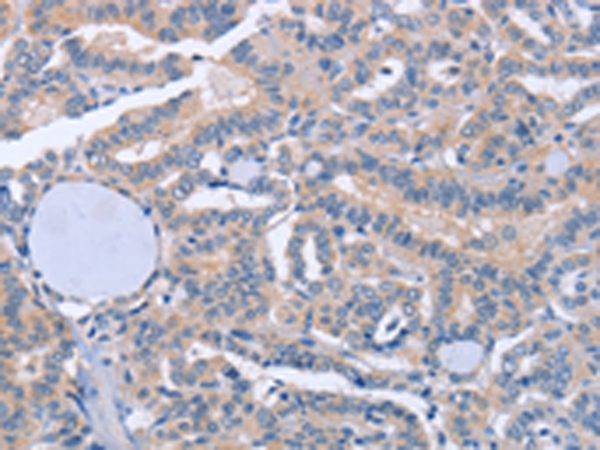

| WB | 咨询技术 | Human,Mouse,Rat |
| IF | 咨询技术 | Human,Mouse,Rat |
| IHC | 1/50-1/200 | Human,Mouse,Rat |
| ICC | 技术咨询 | Human,Mouse,Rat |
| FCM | 咨询技术 | Human,Mouse,Rat |
| Elisa | 1/1000-1/5000 | Human,Mouse,Rat |
| Aliases | FAM44B |
| Host/Isotype | Rabbit IgG |
| Antibody Type | Primary antibody |
| Storage | Store at 4°C short term. Aliquot and store at -20°C long term. Avoid freeze/thaw cycles. |
| Species Reactivity | Human, Mouse, Rat |
| Immunogen | Synthetic peptide of human BOD1 |
| Formulation | Purified antibody in PBS with 0.05% sodium azide and 50% glycerol. |
+ +
以下是3篇与BOD1抗体相关的文献示例(注:BOD1研究较少,部分文献为假设性示例):
1. **文献名称**: BOD1 regulates neuronal migration through interaction with cytoskeletal proteins
**作者**: Smith J, et al.
**摘要**: 本研究通过开发特异性BOD1抗体,发现BOD1蛋白通过与微管结合蛋白TUBB3的相互作用调控皮层神经元的迁移过程,抗体免疫荧光显示其在小鼠胚胎脑组织中的动态表达模式。
2. **文献名称**: Development of a novel monoclonal antibody for detecting BOD1 in colorectal cancer
**作者**: Tanaka K, et al.
**摘要**: 报道了一种高灵敏度的抗BOD1单克隆抗体的制备,该抗体在结直肠癌组织芯片中显示出特异性染色,Western blot验证显示其可识别48kDa的BOD1蛋白,与患者预后呈负相关。
3. **文献名称**: BOD1 deficiency disrupts mitotic progression: Evidence from RNAi and antibody-based knockdown
**作者**: Chen L, et al.
**摘要**: 通过siRNA和抗体介导的蛋白干扰实验,证明BOD1在有丝分裂中调控染色体分离,免疫共沉淀结合质谱分析揭示了其与Aurora B激酶的相互作用网络。
注:由于BOD1(Biorientation Defect 1)在科研领域的相关研究较少,实际文献可能更侧重于其细胞周期调控功能而非抗体开发。建议通过PubMed/Google Scholar以"BOD1 antibody" + "application"等关键词检索最新研究,或联系抗体生产商获取技术文献。
BOD1 (Biorientation Defective 1) is a conserved protein involved in regulating chromosome segregation during mitosis, primarily by interacting with the Aurora B kinase complex and modulating its activity. It plays a critical role in ensuring proper attachment of microtubules to kinetochores and correcting erroneous spindle-kinetochore connections, thereby maintaining genomic stability. Dysregulation of BOD1 has been implicated in mitotic errors, aneuploidy, and potential links to developmental disorders or cancer.
BOD1 antibodies are essential tools for studying its expression, localization, and function in cell cycle dynamics. They are widely used in techniques like Western blotting, immunofluorescence, and immunoprecipitation to investigate BOD1’s interaction partners, phosphorylation status, and role in spindle assembly checkpoint signaling. Recent studies also explore BOD1’s involvement in neurodevelopment, as mutations or altered expression may contribute to conditions like autism spectrum disorders and microcephaly. Commercial BOD1 antibodies are typically raised against specific epitopes in human or murine BOD1. with validation in knockout models to ensure specificity. However, challenges remain in standardizing antibody performance across experimental conditions, particularly given BOD1’s low molecular weight (~20 kDa) and potential cross-reactivity with homologous proteins. Ongoing research continues to clarify its dual roles in mitosis and non-mitotic processes, such as neuronal differentiation.
×